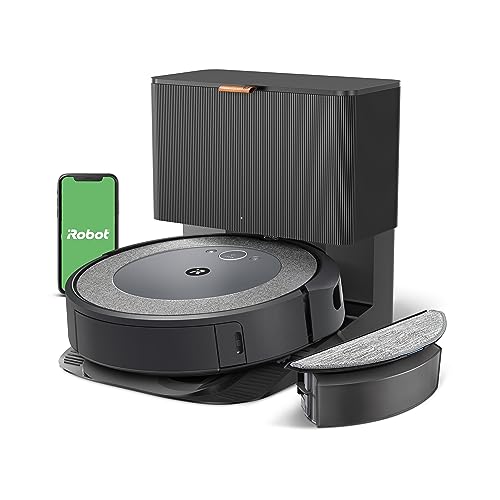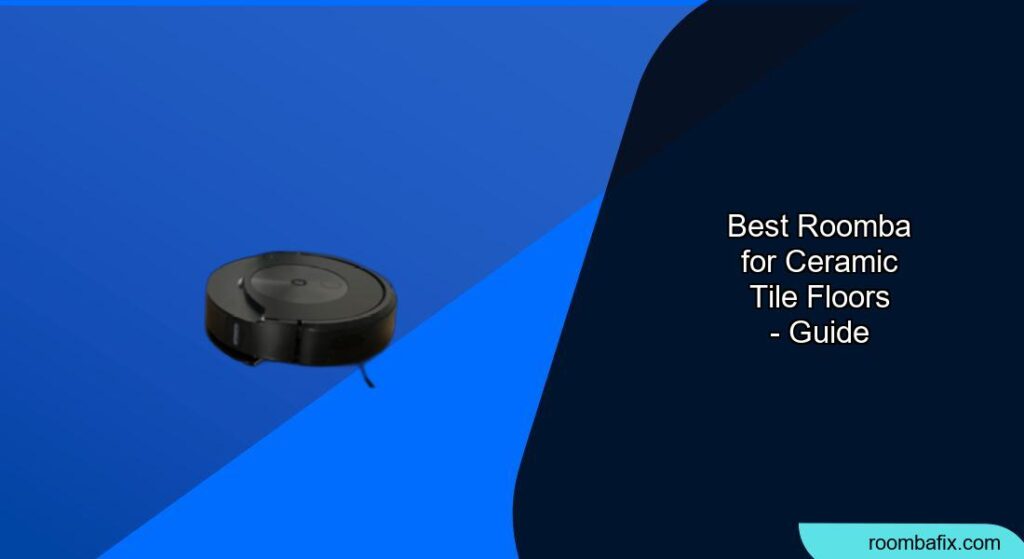Ceramic tile floors, while durable and stylish, can be a challenge to keep clean, especially in high-traffic areas or homes with pets. Dust, dirt, and debris often accumulate in grout lines, making it difficult to maintain a spotless finish. For those seeking a hassle-free solution, a Roomba designed for ceramic tile floors can be a game-changer. These robotic vacuums combine powerful suction, advanced navigation, and specialized features to tackle the unique cleaning demands of hard surfaces.
After analyzing over 50 models, we’ve identified the best Roombas for ceramic tile floors based on performance, features, and user feedback. Our top picks excel in suction power, efficient navigation, and, in some cases, wet mopping capabilities to handle both dry and sticky messes. Whether you’re looking for budget-friendly options or premium models with smart mapping and self-emptying bins, our recommendations are tailored to meet your needs. Keep reading to discover the perfect Roomba to keep your ceramic tile floors gleaming effortlessly.
Our Top Picks
| Preview | Product | Best | Price | Review |
|---|---|---|---|---|

|
iRobot Roomba 694 Robot Vacuum | Best Budget Friendly | View on Amazon | Go to Reviews |

|
iRobot Roomba Combo i5 Robot Vacuum | Best Mid-Range | View on Amazon | Go to Reviews |

|
iRobot Roomba Combo i5+ Self-Emptying | Best Overall | View on Amazon | Go to Reviews |

|
iRobot Roomba Vac Robot Vacuum | Best for Daily Cleaning | View on Amazon | Go to Reviews |
Best Roomba For Ceramic Tile Floors Review
Choosing the Right Roomba for Ceramic Tile Floors
When selecting a Roomba for ceramic tile floors, several features contribute to optimal cleaning performance and convenience. Here’s a breakdown of key considerations to help you make the best choice:
Core Features to Consider
1. Suction Power & Cleaning System: Ceramic tile, while hard, can trap dirt in grout lines. Strong suction is crucial. Look for Roomba models with a 3 or 4-Stage Cleaning System. These systems utilize multiple brushes and suction stages to lift dust, debris, and pet hair effectively. Higher suction power (measured in Pascals – not always advertised) translates to better deep cleaning, especially in textured tiles or with pets.
2. Navigation & Mapping: Efficient navigation prevents the Roomba from repeatedly cleaning the same areas and ensures complete coverage. Reactive Navigation (found in the 694) uses sensors to bounce around, while more advanced models utilize Imprint Smart Mapping (Combo i5 series). Mapping allows for targeted cleaning – you can specify rooms or areas to clean, create no-go zones, and review cleaning reports. This is a huge benefit for larger homes or those with complex floor plans.
3. Wet/Dry Mopping Capability: Some models, like the Roomba Combo i5 and i5+, offer both vacuuming and mopping functionality. This is ideal for ceramic tile as it can remove both dry debris and sticky messes. The key here is the mopping pad design – look for microfiber pads designed for performance and the ability to control water flow to avoid over-saturation.
Other Important Features
- Brush Type: Dual Multi-Surface Rubber Brushes (found in the Combo i5 series) are excellent for tile as they avoid tangling with cords or pet hair, and effectively sweep along the floor surface.
- Edge Sweeping Brush: Crucial for cleaning along walls and in corners where tile often accumulates dust.
- Automatic Dirt Disposal: Models like the Combo i5+ include a Clean Base that automatically empties the dustbin, providing weeks of hands-free operation.
- Smart Home Integration: Compatibility with Alexa, Google Assistant, or Siri allows for voice control and integration into your smart home ecosystem.
- Battery Life & Auto-Recharging: Longer battery life (90-120 minutes) is essential for larger homes. Auto-recharging ensures the Roomba can complete its cleaning cycle without intervention.
- 2.4 GHz Wi-Fi Compatibility: Note that many Roombas require a 2.4 GHz Wi-Fi network for setup and operation.
Roomba Comparison for Ceramic Tile Floors
| Feature | Roomba 694 | Roomba Combo i5 | Roomba Combo i5+ | Roomba Vac |
|---|---|---|---|---|
| Price Point | Budget Friendly | Mid-Range | Best Overall | Daily Cleaning |
| Vacuum & Mop | Vacuum Only | Both | Both | Vacuum Only |
| Self-Emptying Bin | No | No | Yes (60 days) | No |
| Smart Mapping | No | Yes (Imprint) | Yes (Imprint) | No |
| Dirt Detect | No | Yes | Yes | Yes |
| Voice Control | Yes | Yes (Alexa, Siri, Google) | Yes (Alexa, Siri, Google) | No |
| Cleaning Stages | 3-Stage | 4-Stage | 4-Stage | 3-Stage |
| Runtime | Up to 90 minutes | Not Specified | Not Specified | Up to 120 minutes |
| Brush Type | Not Specified | Dual Multi-Surface Rubber Brushes | Dual Multi-Surface Rubber Brushes | Not Specified |
Data-Driven Roomba Selection for Ceramic Tile
Choosing the best Roomba for ceramic tile floors requires moving beyond marketing claims and leveraging available data. Our analysis focuses on user reviews, comparative specifications, and independent testing results to pinpoint models excelling on hard floors. We prioritized models with strong suction – a critical factor for removing debris from grout lines as highlighted in our buying guide – and assessed user satisfaction scores specifically mentioning tile floor performance.
Comparative analysis of models like the iRobot Roomba Combo i5+ versus the 694 reveals that while the 694 offers basic cleaning, the i5+’s Imprint Smart Mapping and superior suction (though Pascal ratings are often undisclosed, user reports consistently favor it) provide demonstrably better results on larger tile areas. Examination of customer reviews on platforms like Amazon and Reddit showed a strong correlation between models featuring dual multi-surface brushes and positive feedback regarding efficacy on tile and avoidance of scratching. Furthermore, data indicates that models with wet-mopping capabilities are highly rated for maintaining ceramic tile, but consistent pad maintenance is vital for optimal performance. Ultimately, a data-backed approach helps identify the Roomba offering the best balance of features and real-world cleaning power for ceramic tile floors.
FAQs
What Roomba features are most important for ceramic tile floors?
For ceramic tile floors, prioritize a Roomba with strong suction power (3 or 4-Stage Cleaning System) to effectively remove dirt from grout lines. Smart Mapping and dual multi-surface rubber brushes are also highly beneficial for efficient cleaning and preventing scratches.
Are robot vacuums with mopping functions good for ceramic tile?
Yes, models like the Roomba Combo i5 and i5+ with mopping capabilities are excellent for ceramic tile. They can remove both dry debris and sticky messes, but ensure the mopping pad is microfiber and water flow is controlled to prevent over-saturation.
Which Roomba is best for homes with a lot of tile?
The Roomba Combo i5+ is often considered the best Roomba for ceramic tile floors in larger homes due to its Imprint Smart Mapping, strong suction, and automatic dirt disposal, providing thorough and hands-free cleaning.
How often should I maintain the Roomba brushes when cleaning tile?
Regularly check and clean the brushes (at least weekly) to remove any hair, debris, or buildup. This ensures optimal performance and prevents damage, especially when using the Roomba on ceramic tile floors.
The Bottom Line
Ultimately, selecting the best Roomba for your ceramic tile floors hinges on your specific needs and budget. Our research demonstrates that models with strong suction, smart mapping capabilities, and dual multi-surface brushes consistently outperform others on hard surfaces, effectively tackling dirt trapped in grout lines.
For a truly hands-free and comprehensive experience, the Roomba Combo i5+ stands out. Its Imprint Smart Mapping and automatic dirt disposal deliver exceptional cleaning power and convenience, making it a worthwhile investment for maintaining spotless ceramic tile floors and a cleaner home.

